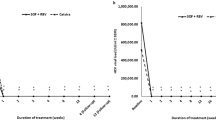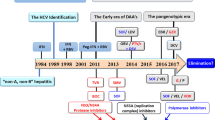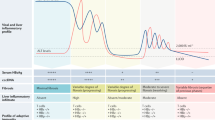Abstract
Several advances afford promise for improving the management of hepatitis C virus (HCV) infection. Current therapies primarily target the immune system; the now proven ability to culture the entire virus in vitro could ultimately facilitate the identification of therapies directly targeting viral replication. Several therapies are presently in development. Taribavirin hydrochloride (Viramidine®, Valeant Pharmaceutical International, Singapore), a ribavirin prodrug, has shown promise, although the rate of sustained virologic response with this agent has been disappointing. The next generation of antivirals will consist of protease and polymerase inhibitors, a number of which are undergoing investigation, initially as monotherapy and subsequently in combination with pegylated interferon and ribavirin. Challenges include the prevention of recurrent HCV infection in liver-transplant recipients and development of a safe and effective HCV vaccine.
Key Points
-
The ability to culture the entire hepatitis C virus (HCV) in vitro is likely to increase the rate of development of new antivirals, particularly polymerase and protease inhibitors
-
VX-950, a protease inhibitor, produces a rapid and dramatic decrease in levels of HCV RNA in a dose-related fashion
-
The addition of the protease inhibitor SCH-503034 to pegylated interferon produces a dose-dependent decrease in levels of HCV RNA beyond that seen with pegylated interferon alone in nonresponders to pegylated interferon plus ribavirin
-
Polymerase inhibitors are undergoing preclinical and clinical trials
-
Ongoing clinical trials of these agents should shed more light on their efficacy and safety in patients with HCV infection
This is a preview of subscription content, access via your institution
Access options
Subscribe to this journal
Receive 12 print issues and online access
$209.00 per year
only $17.42 per issue
Buy this article
- Purchase on Springer Link
- Instant access to full article PDF
Prices may be subject to local taxes which are calculated during checkout



Similar content being viewed by others
References
Zhong J et al. (2005) Robust hepatitis C virus infection in vitro. Proc Natl Acad Sci U S A 102: 9294–9299
Wakita T et al. (2005) Production of infectious hepatitis C virus in tissue culture from a cloned viral genome. Nat Med 11: 791–796
Lindenbach BD et al. (2005) Complete replication of hepatitis C virus in cell culture. Science 309: 623–626
Gish RG et al. (2004) End-of-treatment (EOT) response in therapy-naïve patients treated for chronic hepatitis C with viramidine in combination with pegylated interferon alfa-2a. Hepatology 40 (Suppl 1): 519A
Benhamou Y et al. (2006) The safety and efficacy of Viramidine® plus pegylated interferon alfa-2b versus ribavirin plus pegylated interferon alfa-2b in therapy-naïve patients infected with HCV: phase 3 results [abstract #751]. Presented at the 41st Annual Meeting of the European Association for the Study of the Liver: 2006 April 26–30; Vienna, Austria
Reesink HW et al. (2005) Initial results of a phase 1B, multiple dose study of VX-950, a hepatitis C virus protease inhibitor. Gastroenterology 128 (Suppl): A-697
Reesink HW et al. (2005) Final results of a phase 1B, multiple-dose study of VX-950, a hepatitis C virus protease inhibitor. Hepatology 42 (Suppl 1): 234A–235A
Vertex Pharmaceuticals Incorporated (2006) Vertex successfully completes key studies with VX-950 to prepare for next steps in clinical program [http://www.vpharm.com/Pressreleases2006/pr020706.html] (accessed July 7 2006)
Lawitz EJ et al. (2006) 28 days of the hepatitis C protease C inhibitor VX-950, in combination with peg-interferon-alfa-2a and ribavirin, is well-tolerated and demonstrates robust antiviral effects [abstract #686f]. Gastroenterology 131: 950–951
Zeuzem S et al. (2005) Anti-viral activity of SCH 503034, a HCV protease inhibitor, administered as monotherapy in hepatitis C genotype-1 (HCV-1) patients refractory to pegylated interferon (PEG-IFN-α). Hepatology 42: 233A
Malcolm BA (2005) Modeling of hepatitis C viral dynamics during combination therapy with peginterferon alfa-2B (peg-intron) and the NS3 protease inhibitor SCH 503034 [abstract #1266]. Presented at the Annual Meeting of the American Association for the Study of Liver Disease: 2005 November 11–15; San Francisco, CA
Foy E et al. (2005) Control of antiviral defenses through hepatitis C virus disruption of retinoic acid-inducible gene-I signaling. Proc Natl Acad Sci USA 102: 2986–2991
Kempf DJ et al. (2006) Pharmacokinetic boosting of VX-950, an inhibitor of HCV protease, by co-dosing with ritanovir [abstract #4]. Presented at the 41st Annual Meeting of the European Association for the Study of the Liver: April 26–30; Vienna, Austria
Rodriguez-Torres M (2005) Valopicitabine (nm283) alone and in combination with peg-interferon in patients with genotype 1 chronic hepatitis C: preliminary results from an ongoing phase II, multicenter study. Gastroenterology 128 (Suppl): A-695
Tomei L et al. (2005) HCV antiviral resistance: the impact of in vitro studies on the development of antiviral agents targeting the viral NS5B polymerase. Antivir Chem Chemother 16: 225–245
Viral Hepatitis Resource Center [http://www.cdc.gov/ncidod/diseases/hepatitis/resource/index.htm] (accessed October 2 2006)
Author information
Authors and Affiliations
Ethics declarations
Competing interests
Eugene R Schiff acts as a consultant to Abbott, Achillion Pharmaceutical, Bayer, Bristol Myers Squibb, Cadence Pharmaceuticals, Gilead, GlobeImmune Inc., Idenix, Maxim, National Genetics Institute, Novartis, Ortho-Biotech, Pfizer, PowerMed Ltd., Prometheus, Roche Molecular, Sankyo Pharma Inc., Schering-Plough, and SciClone Pharmaceuticals. He has received grant support from Abbott, Bayer, Bristol Myers Squibb, Coley, Gilead, GlaxoSmithKline, Idenix, Ortho-Biotech, Prometheus, Roche Diagnostics, Roche Molecular, Roche Pharmaceutical, Schering-Plough, SciClone Pharmaceuticals, and Vertex Pharamceuticals. He also receives honoraria for speaking from Abbott, Bristol Myers Squibb, Giliead, GlaxoSmithKline, Idenix, Ortho-Biotech, and Schering-Plough.
Rights and permissions
About this article
Cite this article
Schiff, E. Emerging strategies for pegylated interferon combination therapy. Nat Rev Gastroenterol Hepatol 4 (Suppl 1), S17–S21 (2007). https://doi.org/10.1038/ncpgasthep0691
Received:
Accepted:
Issue Date:
DOI: https://doi.org/10.1038/ncpgasthep0691
This article is cited by
-
In-vitro antiviral activity of Solanum nigrum against Hepatitis C Virus
Virology Journal (2011)
-
Inflammation and Repair in Viral Hepatitis C
Digestive Diseases and Sciences (2008)



